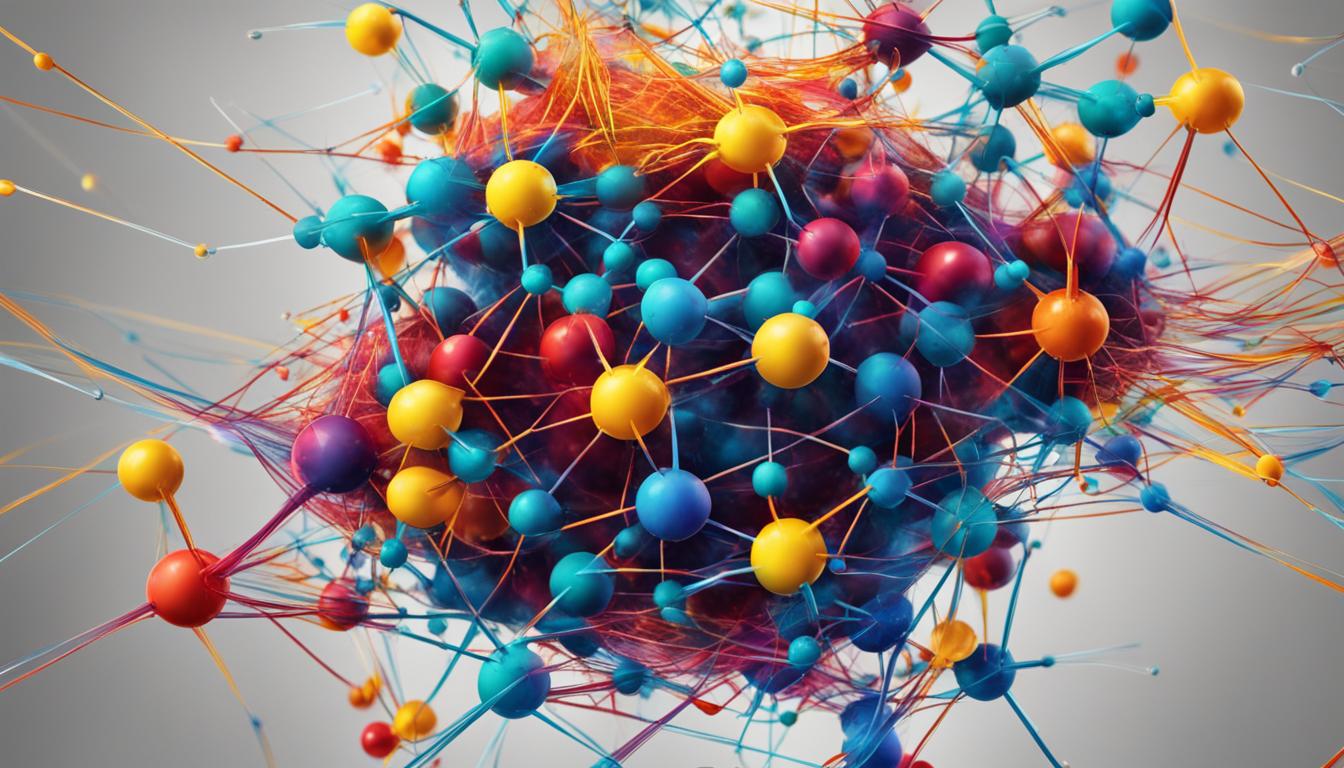Love is a captivating topic that has intrigued scientists across various fields, from anthropology to neuroscience. Researchers have delved into the intricate workings of love, seeking to understand its complexities and unravel its secrets. Through love psychology, the science of love has uncovered fascinating insights into the chemical processes that govern our relationships.
The exploration of love chemistry has revealed that our experiences of love can be categorized into three distinct phases: lust, attraction, and attachment. Each phase is characterized by specific hormones that play a crucial role in shaping the dynamics of our relationships.
Scientists have discovered that lust, the initial stage of attraction, is driven by sex hormones such as testosterone and estrogen. These hormones, secreted by the testes and ovaries, fuel our desire for sexual gratification and are responsible for our innate need to reproduce. Understanding the role of these hormones provides valuable insights into the nature of our sexual desires and the primal forces that influence our attractions.
When it comes to the chemistry of attraction, dopamine and phenylethylamine (PEA) take center stage. Dopamine, a neurotransmitter linked to pleasure and reward, is released in our brains when we feel attracted to someone. This surge of dopamine brings about feelings of excitement and euphoria, creating a strong sense of infatuation. PEA, another chemical in the brain, contributes to the intense butterflies and overwhelming emotions experienced during the early stages of attraction.
As relationships progress, attachment becomes a vital aspect of love. Oxytocin, often referred to as the “love hormone” or “cuddle hormone,” plays a significant role in fostering emotional connection and trust. Oxytocin is released during physical touch, intimacy, and social bonding, deepening the attachment between individuals and promoting a sense of closeness.
While these chemical processes provide valuable insights into the science behind attraction and attachment, it is essential to remember that love is a complex and deeply personal experience. Psychological and emotional factors also play significant roles in shaping our relationships, making love a multifaceted phenomenon that cannot be fully explained by chemistry alone.
Key Takeaways:
- The science of love explores the chemical processes that govern our relationships.
- Lust is driven by sex hormones, such as testosterone and estrogen, which fuel our desire for sexual gratification.
- The chemistry of attraction involves the release of dopamine and phenylethylamine (PEA), leading to feelings of excitement and infatuation.
- Oxytocin, known as the “love hormone,” plays a crucial role in fostering emotional connection and trust.
- Love is a complex experience that cannot be solely explained by chemistry, as psychological and emotional aspects also play significant roles.
Understanding Lust: The Role of Testosterone and Estrogen
Lust, often associated with sexual desire and gratification, is a fundamental aspect of human nature rooted in our innate drive for reproduction. It is influenced by the interplay of various hormones, including testosterone and estrogen. Testosterone, predominantly produced in the testes, is commonly known as the male sex hormone. However, both men and women have testosterone in their bodies, albeit in different proportions. In men, testosterone plays a crucial role in regulating libido, enhancing sexual drive, and promoting the development of secondary sexual characteristics.
Estrogen, on the other hand, is predominantly produced in the ovaries in women. It is responsible for regulating the menstrual cycle and promoting the development of secondary sexual characteristics. While testosterone is often associated with male sexual desire, estrogen also plays a significant role in women’s sexual desire. Both testosterone and estrogen contribute to the complex interplay of hormones that drive sexual desire and gratification in both men and women.
Understanding the role of testosterone and estrogen in lust provides insights into the chemical processes that fuel sexual attraction and desire. It highlights the intricate nature of human sexuality and emphasizes that sexual desire is not solely determined by a single hormone, but rather a complex hormonal balance that varies among individuals.

The Chemistry of Attraction: Dopamine and PEA
When it comes to matters of the heart, chemistry plays a significant role in the attraction between individuals. The brain releases dopamine, a neurotransmitter associated with pleasure and reward, when we feel attracted to someone. This surge of dopamine leads to feelings of excitement and euphoria, creating a sense of exhilaration that is often described as the “love drug.”
In addition to dopamine, another chemical called phenylethylamine (PEA) also contributes to the chemistry of attraction. PEA is responsible for the butterflies in our stomachs and the intense feelings of infatuation that often accompany the early stages of attraction. It heightens our senses and enhances our focus on the object of our desire, making us feel captivated and consumed by their presence.
Understanding the chemistry of attraction can help explain why we feel the way we do when we are drawn to someone. It is a powerful force that drives us to seek connection and intimacy with another person. While chemistry alone is not enough to sustain a long-term relationship, it is often the spark that ignites the flame of love and sets the stage for a deeper emotional connection.

The Role of Dopamine and PEA in Infatuation
“When we feel attracted to someone, our brain releases dopamine, which creates a sense of excitement and euphoria. This surge of dopamine is often accompanied by the release of phenylethylamine (PEA), a chemical that intensifies our feelings of infatuation.”
- Dopamine, the pleasure and reward neurotransmitter, promotes feelings of excitement and pleasure.
- PEA enhances our focus and intensifies our feelings of infatuation.
- The combination of dopamine and PEA creates a powerful cocktail of emotions that fuel the initial stages of attraction.
While the chemistry of attraction is a captivating aspect of love, it is important to remember that it is just one piece of the puzzle. Building a strong and lasting relationship requires more than just intense chemistry. It involves commitment, effective communication, and shared values and goals. However, understanding the chemical processes behind attraction can help us appreciate the exhilarating experience of falling in love and deepen our connection with our partners.
The Role of Oxytocin in Love and Bonding
When it comes to love and bonding, there is a powerful hormone at play: oxytocin. Commonly referred to as the “love hormone” or “cuddle hormone,” oxytocin is a key player in fostering emotional connection and social bonding.

Oxytocin is released in the brain during physical touch, intimacy, and moments of social bonding. It promotes feelings of trust, empathy, and attachment between individuals, deepening the emotional connection in relationships.
Research has shown that oxytocin plays a crucial role in creating a sense of closeness and bonding in romantic relationships. The hormone not only enhances the emotional connection between partners but also contributes to overall relationship satisfaction and happiness.
The Power of Physical Touch
Physical touch, such as hugging, holding hands, or cuddling, triggers the release of oxytocin in the brain. This hormone not only promotes a sense of closeness but also helps reduce stress and anxiety levels. By engaging in regular physical touch with your partner, you can strengthen the bond between you and create a more fulfilling and intimate relationship.
The Importance of Social Bonding
Oxytocin is not limited to romantic relationships. It also plays a role in social bonding with friends, family, and even pets. Building and nurturing social connections can enhance the release of oxytocin, leading to more fulfilling and meaningful relationships across various aspects of life.
In conclusion, oxytocin, the “love hormone,” is a powerful chemical in fostering emotional connection and social bonding. By engaging in physical touch and nurturing social relationships, you can enhance the release of oxytocin and create deeper, more satisfying connections with the people you care about.
The Impact of Serotonin and Norepinephrine in Relationships
As a relationship progresses, the roles of serotonin and norepinephrine become increasingly significant. Serotonin is a neurotransmitter that regulates mood and is associated with feelings of happiness and emotional stability. Its presence creates a sense of calm and contentment within the relationship, fostering a positive and stable environment. On the other hand, norepinephrine, also known as noradrenaline, plays a role in the body’s fight-or-flight response, triggering the release of adrenaline during moments of excitement or stress.
The presence of serotonin and norepinephrine can have a profound impact on the dynamics of a relationship. When serotonin levels are well-maintained, partners are more likely to experience emotional stability, leading to increased relationship satisfaction. This stability provides a solid foundation for open communication and problem-solving, allowing couples to navigate challenges with greater ease.
However, it’s important to note that the balance of serotonin and norepinephrine can vary from person to person, and even within a relationship. The interplay of these neurotransmitters can influence emotional responses and the intensity of feelings experienced during different stages of the relationship. Understanding the impact of serotonin and norepinephrine can help couples navigate these fluctuations and maintain a healthy emotional connection.
Sustaining Long-Term Love: Strategies for Relationship Success
While the initial chemistry and attraction play a role in the formation of a relationship, sustaining long-term love requires more than just chemistry. It involves commitment, effective communication, and shared goals. Engaging in activities that boost dopamine and oxytocin, such as trying new experiences and maintaining physical touch, can help reignite the excitement in a long-term relationship. Furthermore, maintaining a healthy level of serotonin and engaging in self-care can contribute to relationship satisfaction and stability.
Commitment is a crucial element in sustaining long-term love. It means being dedicated to the relationship and prioritizing its success. This commitment involves both partners actively working towards maintaining the connection, even during challenging times. It requires a willingness to make compromises, show forgiveness, and support each other’s personal growth.
Effective communication is another key factor in relationship success. It involves both listening and expressing oneself honestly and respectfully. By actively listening to each other’s needs, concerns, and desires, couples can better understand each other and work towards meeting each other’s needs. Open and honest communication promotes trust, intimacy, and a stronger emotional connection.
Shared goals are essential for sustaining long-term love. Couples who have common aspirations and work towards achieving them together tend to have more satisfying relationships. These shared goals can include building a future together, pursuing personal and professional growth, or even engaging in hobbies and interests that both partners enjoy. Having shared goals provides a sense of purpose and strengthens the bond between partners.

Summary:
- Commitment, effective communication, and shared goals are crucial in sustaining long-term love.
- Engaging in activities that boost dopamine and oxytocin can help reignite the excitement in a long-term relationship.
- Maintaining a healthy level of serotonin and engaging in self-care can contribute to relationship satisfaction and stability.
- Commitment requires dedication, compromises, forgiveness, and support.
- Effective communication involves active listening and honest expression.
- Shared goals provide a sense of purpose and strengthen the bond between partners.
The Limitations of Love Science
The scientific understanding of love has provided valuable insights into the complex interplay of chemistry and emotions in relationships. However, it is important to recognize that love is not solely a product of chemical reactions in the brain. Love is a deeply personal and multifaceted experience that encompasses psychological, emotional, and social aspects.
While scientific research can shed light on the chemical processes behind love, it cannot provide all the answers or make us better at love. Love is an art that requires individual interpretation, understanding, and effort. Each relationship is unique, and what works for one couple may not work for another.
Love psychology and relationship guidance can offer frameworks and strategies for navigating the challenges of love, but they cannot guarantee success or solve all the complexities of human emotions. It is important to remember that no relationship is perfect, and there will always be limitations to our scientific understanding of love.
The Art of Love: Embracing the Complexity
“Love is not a one-size-fits-all formula. It is a journey of discovery, growth, and connection. Understanding the science of love can provide insights, but it is the art of love that truly brings depth and meaning to our relationships.”
Love should be approached with curiosity, empathy, and open-mindedness. It requires actively learning about our partner, communicating effectively, and adapting to the changing dynamics of the relationship. Love is not static; it evolves and requires continuous effort.
While science can inform us about the chemical processes behind love, it is up to us to cultivate and nurture the emotional connection. Love is a beautifully complex experience that goes beyond scientific explanations. By recognizing the limitations of love science and embracing the art of love, we can create fulfilling and meaningful relationships.

Learning from Long-Term Relationships: Insights from Couples Therapy
Long-term relationships, such as marriages, offer valuable insights into the complexities of love and the dynamics between couples. Couples therapy, an essential resource for many struggling relationships, provides unique perspectives on what it takes to maintain a healthy and fulfilling partnership.
Psychiatrists and researchers who specialize in couples therapy have not only learned from their professional experiences but also from their personal relationships. By studying the triumphs and mistakes of others, couples can gain wisdom to navigate the challenges and cultivate a long-lasting bond.
Marriage, in particular, offers a wealth of insights into sustaining love over the years. The experiences of couples who have weathered various storms can shed light on effective strategies for communicating, resolving conflicts, and nurturing emotional connection. Through therapy and open dialogue, couples can gain valuable relationship insights that can help them thrive.
“Couples therapy provides a safe space for partners to explore their emotions, address underlying issues, and work towards healing and growth. It offers guidance and tools to enhance communication, build trust, and strengthen bonds. Seeking professional help is not a sign of weakness but a commitment to the relationship.”
Long-term relationships can also provide valuable lessons about handling challenges, such as navigating the ups and downs of marriage, managing stress, and combating feelings of loneliness. By learning from the experiences of others, couples can gain a deeper understanding of the complexities of love and develop strategies to overcome obstacles that may arise throughout their journey together.

Key Takeaways:
- Couples therapy offers valuable insights from both professional and personal experiences.
- Marriages provide unique perspectives on building and sustaining long-term love.
- The experiences of others can guide couples in navigating challenges and nurturing emotional connection.
- Long-term relationships offer wisdom on handling obstacles and combating loneliness.
The Impact of Children on Relationships

Raising children can be one of the most rewarding experiences in life, but it can also bring unique challenges to a relationship. The demands of parenting, combined with the pressures of work and everyday life, can put a strain on a couple’s connection. Finding a healthy balance between parenting responsibilities and nurturing the romantic partnership is essential for maintaining a strong and fulfilling relationship.
Work-life balance becomes even more critical when children are in the picture. It’s important for partners to prioritize time for each other, whether it’s going on date nights, engaging in shared hobbies, or simply having open and meaningful conversations. Making an effort to create moments of connection and intimacy can help counterbalance the stress and demands of parenting.
Child stressors can also impact a relationship. From dealing with sleepless nights to managing challenging behaviors, parents often face additional sources of stress. It’s crucial for partners to support each other during these challenging times, offering a listening ear, sharing responsibilities, and finding ways to de-stress together. By working as a team and addressing these stressors head-on, couples can navigate the ups and downs of parenting while maintaining a strong foundation for their relationship.
The Pressure of Relationship Expectations
Society often places unrealistic expectations on romantic partners, expecting them to fulfill multiple roles. Couples are expected to be best friends, passionate lovers, co-parents, and more. This societal pressure can put a strain on relationships and make it challenging for couples to meet all these expectations. It’s important to recognize and discuss these pressures openly and honestly, allowing both partners to express their needs and find a balance that works for them.
“Many couples feel overwhelmed by the societal expectations placed on them. It’s important to remember that every relationship is unique, and partners should define their own roles based on mutual understanding and respect.”
Companionship is a vital aspect of a romantic relationship, but it’s essential to remember that true companionship is built on mutual support, understanding, and respect. It’s unrealistic to expect one person to fulfill all our emotional needs and be everything to us. By acknowledging and embracing the diversity of roles and qualities that exist within a partnership, couples can create a strong foundation of companionship that allows them to grow and thrive together.
“In a healthy relationship, both partners should feel comfortable expressing their needs and desires, without the fear of judgment or disappointment. This open communication is crucial for debunking societal myths and unrealistic expectations.”
Recognizing Unrealistic Expectations
It’s crucial for couples to recognize and challenge the unrealistic expectations society places on them. By discussing these expectations and identifying which ones are realistic and achievable, partners can alleviate the pressure and work towards building a relationship that aligns with their individual values and needs.
- Have honest conversations about societal expectations and how they impact your relationship
- Identify and prioritize the expectations that are most important to both partners
- Set realistic goals and boundaries that align with your values and individual needs
- Focus on fostering mutual respect, understanding, and support
By fostering open communication and embracing individuality within the relationship, couples can create a partnership that is built on authenticity, companionship, and shared values, ultimately leading to a stronger and more fulfilling connection.

Nurturing Love for the Long Haul: Key Takeaways
Building and sustaining a long-term relationship requires ongoing effort and nurturing. While chemistry plays a significant role in the initial attraction and bonding, it is essential to understand that love is an art that requires continuous growth and emotional connection. Here are some key takeaways to help couples nurture their love for the long haul:
- Open and Honest Communication: Effective communication is the foundation of a healthy relationship. It is crucial to express your needs, fears, and desires openly and honestly. By practicing active listening and empathetic understanding, couples can strengthen their emotional connection and address any issues that may arise.
- Quality Time and Shared Activities: Spending quality time together and engaging in shared activities is vital for maintaining intimacy and connection. Whether it’s going on regular date nights, trying new hobbies, or creating shared goals, investing time and effort into shared experiences can reignite the spark and deepen the emotional bond.
- Embracing Growth and Change: Both individuals in a relationship are constantly growing and evolving. It is important to embrace personal growth and support each other’s individual journeys. By allowing room for change, couples can navigate challenges and adapt to new circumstances, strengthening their relationship in the process.
- Showing Appreciation and Affection: Expressing love and appreciation is essential in nurturing a long-term relationship. Small gestures of affection, acts of kindness, and verbal expressions of appreciation can go a long way in making your partner feel valued and loved.
Remember, nurturing love for the long haul requires commitment, understanding, and continuous effort. By prioritizing effective communication, investing in quality time together, embracing personal growth, and expressing appreciation, couples can create a strong foundation for lasting love.
Conclusion
The science of love delves into the intricate chemistry that governs our emotions and actions in relationships. While the chemical processes in our bodies play a significant role in forming and sustaining love, it is important to recognize that love is not solely defined by chemistry. It is an art that requires dedication, communication, and effort.
Understanding the chemistry of love can provide valuable insights into the complexities of relationships. From the role of hormones like dopamine and oxytocin in attraction and bonding, to the impact of serotonin and norepinephrine on emotional stability, the science of love offers a glimpse into the inner workings of our hearts.
However, lasting love goes beyond chemistry. It requires commitment, effective communication, and shared goals. By prioritizing the emotional connection and nurturing the relationship, couples can create a foundation for true happiness and long-term fulfillment. Love is a journey that evolves over time, and with the right ingredients of art and science, it can blossom into a beautiful and lasting bond.
FAQ
What are the main chemical processes involved in love?
Love involves three main processes: lust, attraction, and attachment. Lust is driven by sex hormones like testosterone and estrogen. Attraction is characterized by the release of dopamine and phenylethylamine (PEA). Attachment is promoted by the “love hormone” oxytocin.
How does lust work?
Lust is driven by the desire for sexual gratification and reproduction. It involves the production of sex hormones like testosterone and estrogen in the testes and ovaries, stimulated by the brain’s hypothalamus.
What chemicals are involved in attraction?
Attraction is associated with the release of dopamine, which brings feelings of pleasure and reward. Another chemical called phenylethylamine (PEA) also plays a role in the intense infatuation often felt during the early stages of attraction.
What is the role of oxytocin in love?
Oxytocin, known as the “love hormone” or “cuddle hormone,” is released during physical touch, intimacy, and social bonding. It promotes trust, empathy, and attachment, enhancing the emotional connection between individuals.
How do serotonin and norepinephrine impact relationships?
Serotonin regulates mood and promotes emotional stability and happiness, contributing to a sense of calm in the relationship. Norepinephrine, on the other hand, is associated with the fight-or-flight response and can create an adrenaline rush in moments of excitement or stress within the relationship.
What is needed to sustain long-term love?
Sustaining long-term love requires commitment, effective communication, and shared goals. Engaging in activities that boost dopamine and oxytocin, as well as maintaining a healthy level of serotonin and self-care, can help reignite excitement and contribute to relationship satisfaction and stability.
Can science explain all aspects of love?
While scientific research provides valuable insights into the chemical processes behind love, love is a multifaceted and deeply personal experience that cannot be entirely explained by chemistry alone. Psychological and emotional aspects also play significant roles.
What can couples learn from long-term relationships and couples therapy?
Couples therapy and the experiences of long-term couples offer valuable insights into the complexities of love. Psychiatrists and researchers who specialize in couples therapy have learned from their patients’ relationships and their own experiences, providing wisdom to navigate challenges and maintain healthy relationships.
How do children impact relationships?
Children can be a significant stressor on relationships, as the demands of parenting often take priority. Creating a healthy work-life balance and prioritizing the couple’s relationship is essential for maintaining a strong partnership.
What pressures do societal expectations place on romantic partners?
Society often expects romantic partners to fulfill multiple roles, such as being best friends, lovers, and co-parents. Recognizing and discussing these societal pressures can help couples navigate their roles and find a balance that works for them.
How can love be nurtured for the long term?
Nurturing love for the long term requires effort, intentionality, and understanding the chemical processes behind love. Engaging in activities that boost dopamine and oxytocin, effective communication, and prioritizing the relationship can enhance the emotional connection and create a foundation for lasting love.


